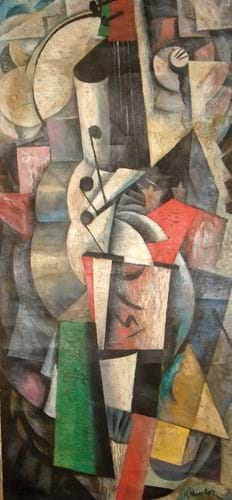In 2013, Itzhak Zarug, 73, was arrested following raids on his apartments and galleries and a collection of over 1800 works was seized. He was imprisoned without bail and spent almost three years awaiting trial.
The works under investigation were primarily Russian paintings including pictures attributed to Kandinsky, Goncharova and Chagall.
With 40 oils ascribed to Kazimir Malevich and a further 100 works on paper by the artist, the potential value of the collection ran into billions of pounds.
After a five-year investigation and multiple expert witnesses giving evidence at the trial, German state prosecutors were unable to prove their central claims that the collection was fake and that Zarug had masterminded a forgery ring.
The judgment for the case, which was read out in a court in Wiesbaden on March 15, withdrew these two main indictments and the collection has now been returned to Zarug.
A third indictment relating to pigment samples and the provenance of three confiscated works was upheld against Zarug and his business partner.
However, they intend to appeal the decision which carries a prison sentence (already served on remand) and a substantial fine.
During the trial, the German court heard scientific evidence and also requested assistance from authorities in Israel, France Spain, Switzerland and the UK. Two of the experts involved in this case were Dr Erhard Jägers, a chemist, specialising in the analysis of works of art and a director of the Microanalytical Laboratory in Borheim, German, and the Russian avant-garde scholar and President of the International Chamber of Russian Modernism, Dr Patricia Railing.
Dr Erhard Jägers said: “We have examined a large number of paintings of the Russian avant-garde belonging to the Zarug collection. In the course of the court proceedings, the results were verified and confirmed by different public institutions. It appears therefore that both the collection of the analytical data with the help of state-of-the-art equipment and their interpretation based on our long-standing experience were of excellent quality.”
Shortly after the judgment had been read out in court, Mr Zarug said: “Reason and justice have prevailed, and my pictures can at last be enjoyed without suspicion or concern. I am pleased that the allegations against me and against my pictures have been proven to be unfounded.
“We wish to thank the German authorities for the diligence, objectivity and intensity of their investigation into my collection. The degree of thorough scientific and historical analysis can leave no doubt that these paintings are true and genuine masterpieces of the Russian avant garde.
“If only the same diligence had been evident before I was arrested three years ago, we may have been spared this ordeal. Issues of authenticity are rampant in the market for the Russian avant-garde, but it is no excuse for a witch-hunt.”
















